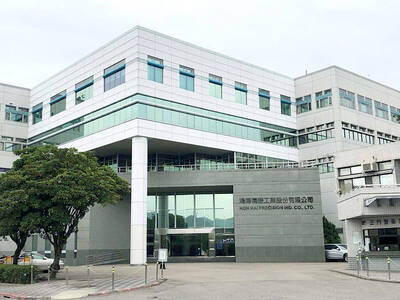Taiwan’s business climate monitor last month displayed “yellow-blue” for the first time in 26 months as an economic slowdown worsened — apparently evolving into a recession with no quick resolution, the National Development Council (NDC) said yesterday.
The overall score plunged 6 points to 17, just one point above a “blue” reading — indicating recession — showing that economic challenges loom, the council said.
The monitor has not had a “yellow-blue” reading since July 2020, it said.
“It is hard to tell whether the monitor would turn blue or improve this month, as many subindices are hovering around the borderline,” NDC research director Wu Ming-huei (吳明蕙) told a news conference in Taipei.
“Things are evidently deteriorating and challenges look massive in the next few months,” Wu said.
The council uses a five-color system to indicate the state of the nation’s economy, with “green” meaning steady growth, “red” suggesting a boom and “blue” signaling a recession. Dual colors indicate a shift to a stronger or weaker state.
Wu attributed the slowdown to fast inflation, monetary tightening, and geopolitical conflicts wreaking havoc on global financial markets and consumer demand for Taiwan’s exports, mainly electronics used in smartphones, laptops, data centers, vehicles and Internet of Things applications.
Inventory adjustments had proceeded more slowly and would need a lot more time than previously expected, she said.
Major Taiwanese firms gave conservative guidance for this quarter and expect business to weaken further next year, she said.
The index of leading indicators, which indicate the economic situation for the subsequent six months, shrank 0.92 percent to 96.06, as export orders, share prices, new construction floor space and labor accession rates all had negative cyclical movements, the NDC said.
The value of imported semiconductor equipment was the only indicator with a positive development, it said.
It is the 11th consecutive month that the index declined, with a cumulative fall of 7.59 percent, it said.
The index of coincident indicators, which reflects the current economic situation, lost 1.82 percent to 95.01 last month, Wu said, adding that it has contracted for seven months in a row, with its cumulative retreat widening to 8.2 percent.
NDC Minister Kung Ming-hsin (龔明鑫) earlier yesterday told lawmakers that the government is striving to maintain GDP growth of 3.3 percent this year.
The goal looks doable thus far, but would be difficult to achieve next year, Kung said.

Nvidia Corp chief executive officer Jensen Huang (黃仁勳) on Monday introduced the company’s latest supercomputer platform, featuring six new chips made by Taiwan Semiconductor Manufacturing Co (TSMC, 台積電), saying that it is now “in full production.” “If Vera Rubin is going to be in time for this year, it must be in production by now, and so, today I can tell you that Vera Rubin is in full production,” Huang said during his keynote speech at CES in Las Vegas. The rollout of six concurrent chips for Vera Rubin — the company’s next-generation artificial intelligence (AI) computing platform — marks a strategic

Shares in Taiwan closed at a new high yesterday, the first trading day of the new year, as contract chipmaker Taiwan Semiconductor Manufacturing Co (TSMC, 台積電) continued to break records amid an artificial intelligence (AI) boom, dealers said. The TAIEX closed up 386.21 points, or 1.33 percent, at 29,349.81, with turnover totaling NT$648.844 billion (US$20.65 billion). “Judging from a stronger Taiwan dollar against the US dollar, I think foreign institutional investors returned from the holidays and brought funds into the local market,” Concord Securities Co (康和證券) analyst Kerry Huang (黃志祺) said. “Foreign investors just rebuilt their positions with TSMC as their top target,

REVENUE PERFORMANCE: Cloud and network products, and electronic components saw strong increases, while smart consumer electronics and computing products fell Hon Hai Precision Industry Co (鴻海精密) yesterday posted 26.51 percent quarterly growth in revenue for last quarter to NT$2.6 trillion (US$82.44 billion), the strongest on record for the period and above expectations, but the company forecast a slight revenue dip this quarter due to seasonal factors. On an annual basis, revenue last quarter grew 22.07 percent, the company said. Analysts on average estimated about NT$2.4 trillion increase. Hon Hai, which assembles servers for Nvidia Corp and iPhones for Apple Inc, is expanding its capacity in the US, adding artificial intelligence (AI) server production in Wisconsin and Texas, where it operates established campuses. This

US President Donald Trump on Friday blocked US photonics firm HieFo Corp’s US$3 million acquisition of assets in New Jersey-based aerospace and defense specialist Emcore Corp, citing national security and China-related concerns. In an order released by the White House, Trump said HieFo was “controlled by a citizen of the People’s Republic of China” and that its 2024 acquisition of Emcore’s businesses led the US president to believe that it might “take action that threatens to impair the national security of the United States.” The order did not name the person or detail Trump’s concerns. “The Transaction is hereby prohibited,”